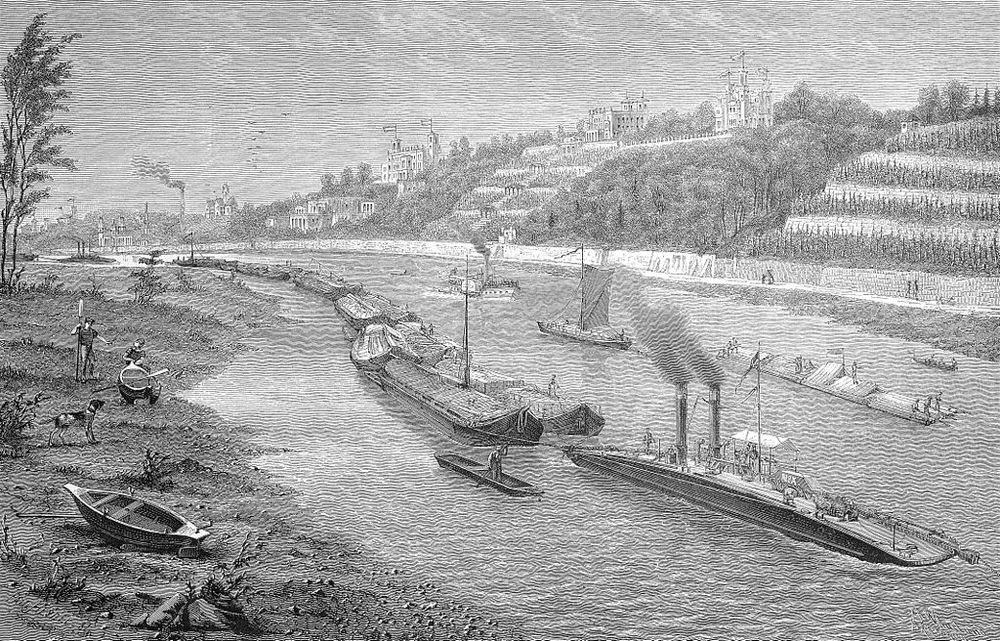
In his travelogue, A Tramp Abroad, Mark Twain describes an encounter with a curious boat on the River Neckar in Germany.
We ran forward to see the vessel. It proved to be a steamboat—for they had begun to run a steamer up the Neckar, for the first time in May. She was a tug, and one of a very peculiar build and aspect. I had often watched her from the hotel, and wondered how she propelled herself, for apparently she had no propeller or paddles. ....
As she went grinding and groaning by, we perceived the secret of her moving impulse. She did not drive herself up the river with paddles or propeller, she pulled herself by hauling on a great chain. This chain is laid in the bed of the river and is only fastened at the two ends. It is seventy miles [one hundred and ten kilometers] long. It comes in over the boat's bow, passes around a drum, and is payed out astern. She pulls on that chain, and so drags herself up the river or down it. She has neither bow or stern, strictly speaking, for she has a long-bladed rudder on each end and she never turns around. She uses both rudders all the time, and they are powerful enough to enable her to turn to the right or the left and steer around curves, in spite of the strong resistance of the chain. I would not have believed that that impossible thing could be done; but I saw it done, and therefore I know that there is one impossible thing which can be done. What miracle will man attempt next?
What Mark Twain described is known as a chain boat. These boats were once very popular in European rivers in the 19th and early 20th centuries. It consisted of a fixed chain that lay along the bed of a river following the watery course as far as navigation was required. Specially made chain boats lifted the chain from the riverbed at the bow end, passed it over the deck of the boat, and sank it back into the river at the back. On the deck, the chain passed around a heavy winch powered by a steam engine that pulled at the chain and drove the boat forward.
Chain shipping revolutionized inland shipping during the Industrial Revolution in the second half of the 19th century in Europe to an extent until ships powered by a steam engine became self-propelled. Previously, boats had to towed along the river by humans or beasts of burden. The chain drive of these riverboats made optimal use of still relatively low-powered steam engines of that period. In addition, the boats were especially well suited to shallow or fast-flowing rivers where paddle steamers could not be used.

Jacopo Mariano's concept of ship haulage.
The concept was first visualized in the 15th century by Italian engineer Jacopo Mariano. In a manuscript dating to 1438, Mariano included an illustration depicting a boat pulling itself upstream on a cable laid along the river. The cable was shown wrapped around a central shaft driven by two, side-mounted water wheels. Behind the river craft was a small boat-like object that was pulled by the current, holding the cable taut and thus ensuring the necessary friction on the shaft.
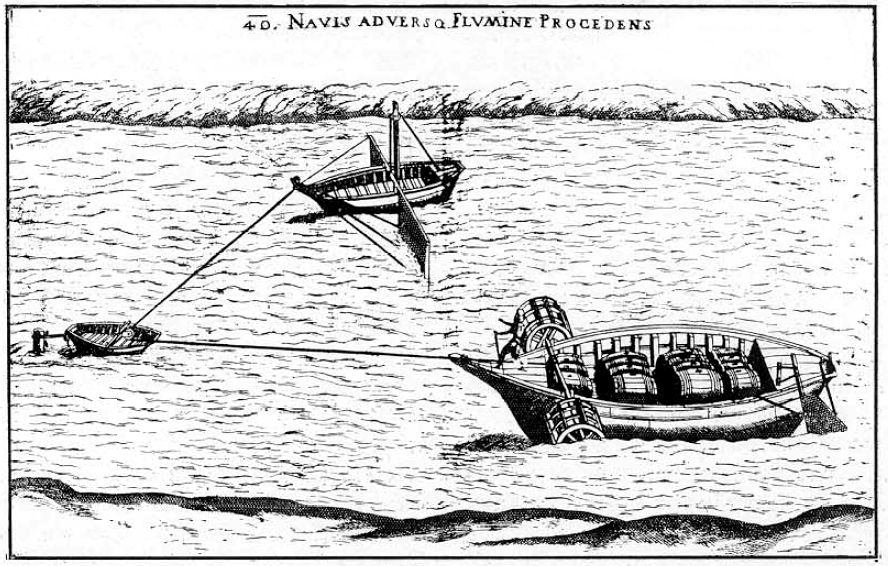
Fausto Veranzio's concept of ship haulage around 1595
In 1595, Croatian polymath Fausto Veranzio described a system of cable boat navigation that enabled greater speeds. It consisted of two boats connected by a cable that went round a pulley anchored firmly to the riverbed. One boat travelled downstream driven by large water sails and hauled the larger boat upstream against the current. The large barge had two, side-mounted water wheels that coiled up the cable and increased its speed further.
In 1723 mathematics professor Nicolaus Molwitz from Magdeburg made a proposal for a machine that would help boats negotiate the fast currents below Magdeburg's bridges. His machine consisted of two horizontal shafts, the towing cable being turned around the front shaft in such a way that it was continuously being unwound from it again and onto the rear shaft. With the additional use of levers, it should have been possible for five or six men to successfully effect the passage of the boat through the section of the river that needed fifty. The machine was never built, but from the description left behind by Paul Jacob Marperger, elements of this basic principle seem to be similar to those subsequently used later in building chain boats. This section of river was later to become the starting point for the first chain boats in Germany.
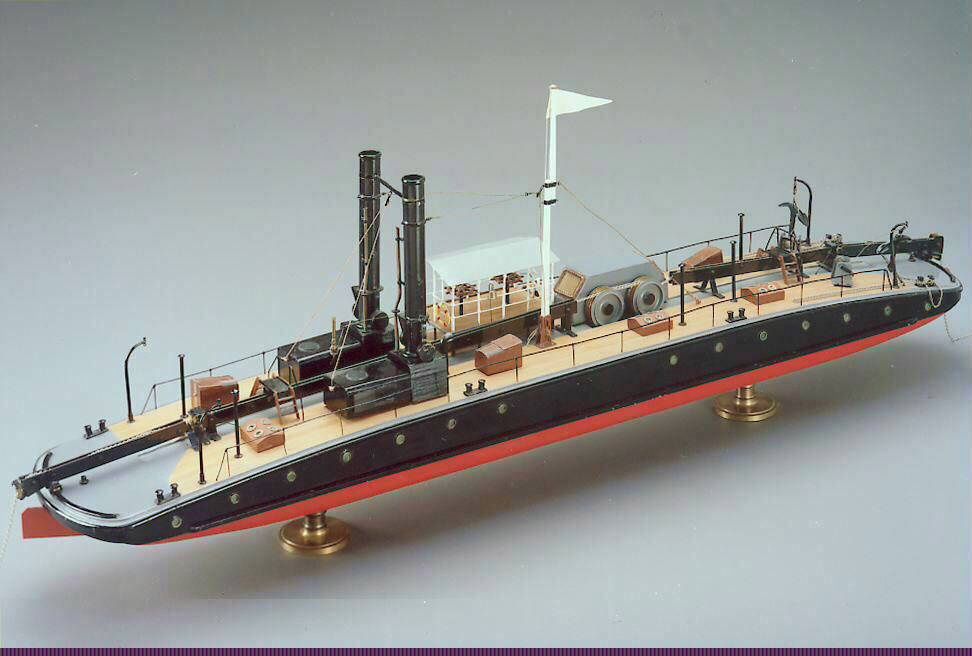
Model of a chain boat at Technoseum State Museum for Technology and Work. Photo: Klaus Luginsland/Wikimedia Commons
Serious attempts to move boats by chains were made only in the 1820s in France. Engineers Tourasse and Courteaut attached a roughly 1-kilometre-long cable made of hemp on the banks of the River Saône near Lyon. This was wound around a rotating drum on board, which hauled the boat forward. Six horses were used to rotate the drum. Later, Tourasse and Courteaut built another system on the Rhone between Givors and Lyon, but replaced the horses with a stream engine. Then Vinochon de Quémont carried out trials on the River Seine in which the rope was replaced with a chain. In 1826, M.F. Bourdon tested a variant with two steam ships. One of the ships drove forward using a paddle wheel whilst simultaneously uncoiling a rope, 600 meters long. After unwinding the rope fully, the ship anchored and hauled the second tugboat with its chain of attached barges up to itself, the rear tugboat assisting the process with its own power. The two boats then changed position and repeated the procedure.
From the time of those early attempts in the first half of the 19th century, chain boat technology improved steadily and the first successful use of chain boats in France took place. In 1839, the first technically and economically successful chain steamer, Hercule, was built and on a roughly 5-to-6-kilometer-long stretch of fast-flowing water on the River Seine within the city of Paris. After that, other French rivers and canals were also provided with chains. By 1873, over 500 km of chain was laid along the Seine.

The chain of a chain boat at the Canal of Burgundy, France. Photo: Veit Feger/Wikimedia Commons
In Germany, chain boat navigation began in 1866 with the laying of an iron chain in the Elbe between Magdeburg-Neustadt and Buckau, a distance of about 6 km. It regularly hauled barges up to 250 tons using an engine generating only 60 hp. By 1871, the chain had extended from Magdeburg to Schandau on the Bohemian border. Three years later the route was extended northwestwards to Hamburg. Up to 28 chain boats rattled upstream over a total length of 668 kilometers. These boats were used until the late 1920s when large sections of the chains were lifted, keeping only those in the most difficult sections. The final section was closed only after the end of the Second World War.
On the Saale, chain boats became operational in 1873, running from its river mouth to the Calbe, and by 1903 services had been extended to Halle, a total of 105 kilometers. Chain shipping on the Saale suffered a sharp decline with the outbreak of World War I and was completely discontinued in 1921.
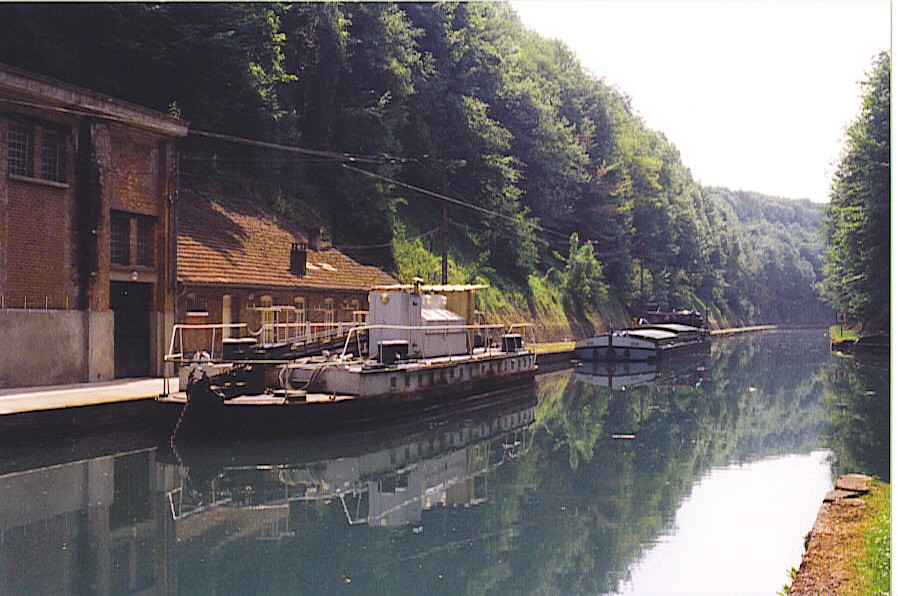
A chain boat on the Canal de Saint-Quentin, France. Photo: Boerkevitz/Wikimedia Commons
Chain towing revolutionized Elbe shipping, which until then had been shaped by towing for centuries. Chain towing reduced the crew on the barges by more than half, while shortening delivery times, which in turn allowed the captain to undertake as many as three times the number of journeys previously possible. Shipping goods by chain boats became so reliable that many goods that had been transferred by railways were switched back to the cheaper waterway.
Chain boats became obsolete by the early 20th century as steam engines became more powerful. The new paddle steamers were able to deliver greater traction for lower coal consumption. The compound engine on the paddle steamer, based on its power output, needed only about half the amount of coal. Chain steamers were not able to take advantage of these compound steam engines because of their uneven operation. Besides, chain shipping companies suffered from high investment and maintenance costs. The building of dams and locks also created artificial barriers that prevented chain boats from operating.
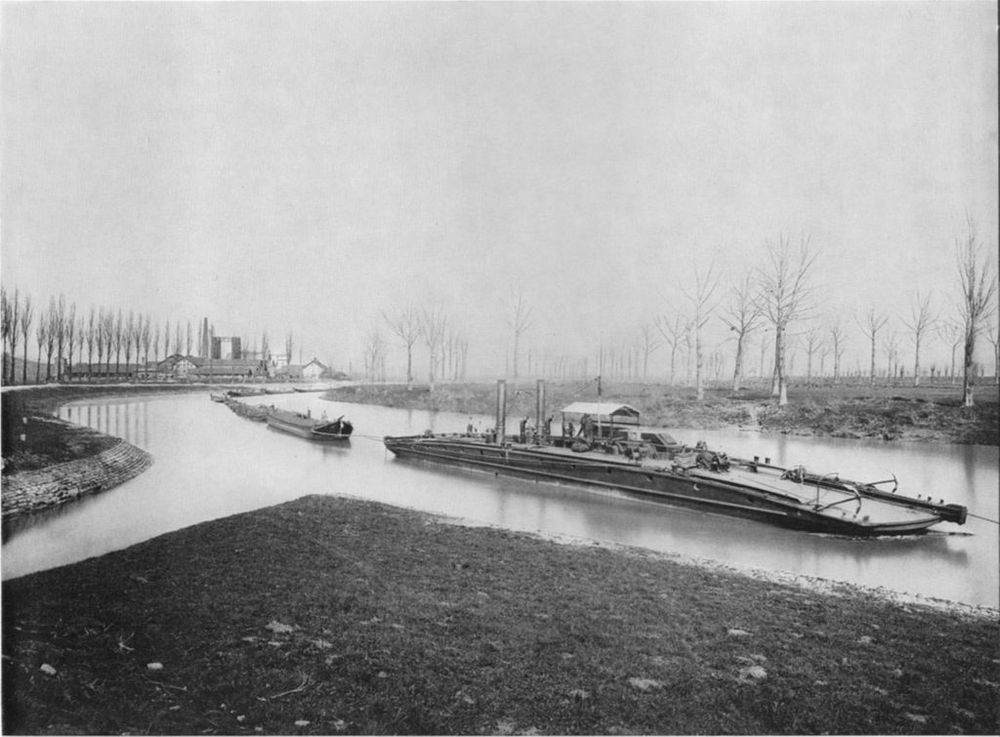
A Kettenschiff (chain ship) on the Neckar near Heilbronn, circa 1885.



Comments
Post a Comment